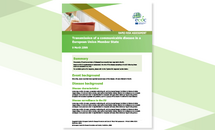Assessment of the further spread and potential impact of the SARS-CoV-2 Omicron variant of concern in the EU/EEA, 19th update
This Rapid Risk Assessment extends the assessment of the further emergence and potential impact of Omicron in the context of ongoing transmission of the Delta variant that was published on 15 December 2021, to include new epidemiological data on the spread of Omicron, new data on vaccine uptake, updated forecasts, and the latest evidence on Omicron transmissibility, severity, immune escape, vaccine effectiveness, post-COVID-19 condition, and non-pharmaceutical interventions.
Executive Summary
The SARS-CoV-2 Omicron variant of concern (VOC) is rapidly replacing SARS-CoV-2 Delta in most European Union/European Economic Area (EU/EEA) countries, and is broadly following a west-to-east progression. As pointed out by earlier in vitro and in vivo studies, Omicron can to a degree evade the protective effects of antibodies elicited by vaccination or natural infection according to factors such as number of vaccinations or time since last vaccination, thus leaving large portions of the EU/EEA population susceptible to infection. This has resulted in sharp increases in the number of COVID-19 cases, reaching an unprecedented intensity of community transmission across the region.
In comparison with earlier circulating variants, Omicron infections appear less likely to lead to a severe clinical outcome that requires hospitalisation or ICU admission. Hence, although the current overall 14-day notification rate in the EU/EEA is 2 621 cases per 100 000 population, which is three times higher than the highest peak observed during the pandemic to date, hospitalisation rates and mortality are below the levels observed in earlier pandemic waves. However, the number of cases among older people has been increasing more recently in several EU/EEA countries, and this could result in a delayed increase of severe cases and deaths. Although the reduction in severity is partially due to inherent characteristics of the virus, results from vaccine effectiveness studies have shown that a significant role in preventing severe clinical outcomes from Omicron infection is played by vaccination, with effectiveness against severe illness increasing significantly among people having received three vaccine doses. Since vaccination uptake is variable across EU/EEA countries (country range: 28.4–82.9%, average 69.4%) and since the uptake of booster doses is still at suboptimal levels in the majority of EU/EEA countries (80% of EU/EEA countries with booster uptake among adults below 60% as of week 2-2022), the expected impact of Omicron will vary, but countries with lower vaccine uptake are expected to experience the highest disease burden. Furthermore, given the very high levels of community transmission observed regardless of overall vaccine uptake, leading to many people being sick at the same time, countries with very high vaccine uptake will also likely undergo a period of substantial pressure on their healthcare systems and on the functioning of the society as a whole (mainly through absence from work and education).
Mathematical modelling results demonstrate that there is a substantial proportion of the population that remains vulnerable to severe outcomes across all EU/EEA countries, especially in those with lower vaccination coverage. Static projections show hospitalisations and mortality are expected to have a proportionally greater impact among people 60 years and older but will also impact people younger than 60 years. In response to the high incidence of Omicron, protection against the risk of high hospitalisation burden can be accomplished by increasing overall vaccination uptake, including rapidly administering booster doses, especially in the older and at-risk population, will protect against the risk of high hospitalisation burden. Furthermore, the vaccines and boosters provide additional longer-term benefits for individuals and society (e.g. preventing absence from work or education and post-acute COVID-19 syndrome).
There are no data so far on the incidence of prolonged symptoms after COVID-19 due to Omicron, nor on whether this differs from the incidence of post-COVID syndrome brought about by previously circulating variants of SARS-CoV-2. It is plausible that the large number of cases of Omicron infection may be followed by a high incidence of post-COVID-19 condition, with a proportionally higher incidence among people who are unvaccinated.
While we expect to be moving towards a more sustainable situation with COVID-19 circulating at manageable levels, we currently remain in a public health emergency pandemic situation, and it is important to note that even in a post-pandemic phase SARS-CoV-2 could still periodically cause high levels of strain on healthcare systems and lead to large outbreaks. Thus, moving forward, multi-layered surveillance, preparedness, and response strategies for addressing COVID-19 will be essential.
Download
Erratum: This document was adjusted on 27 January at 17:25 to reflect that the current overall 14-day notification rate in the EU/EEA is three times higher than the highest peak observed during the pandemic to date (rather than four times).





